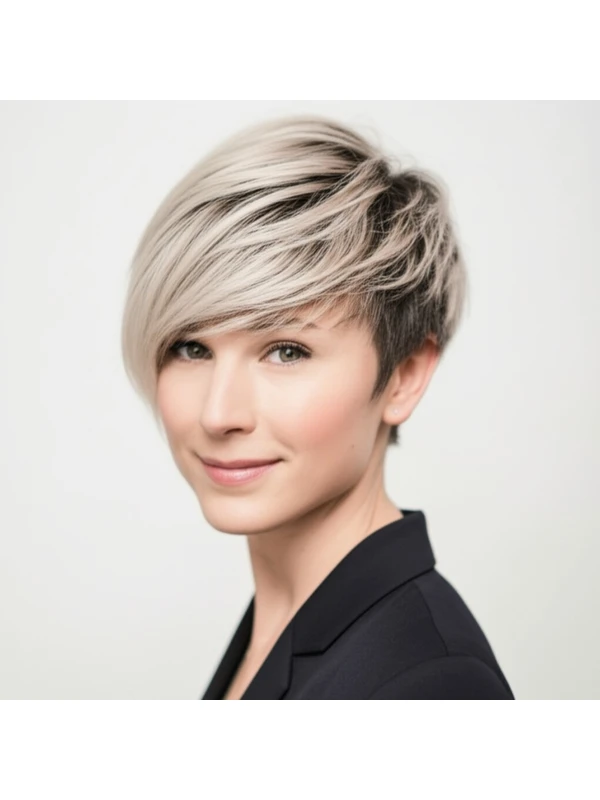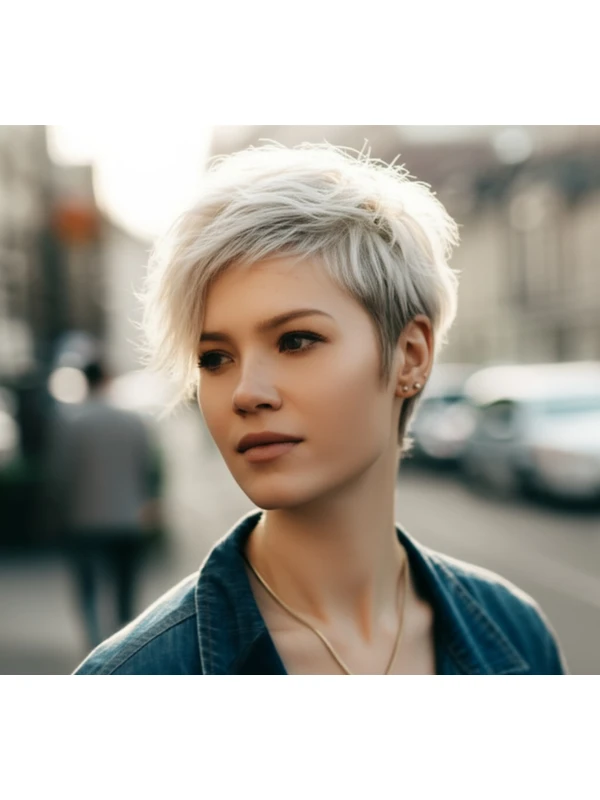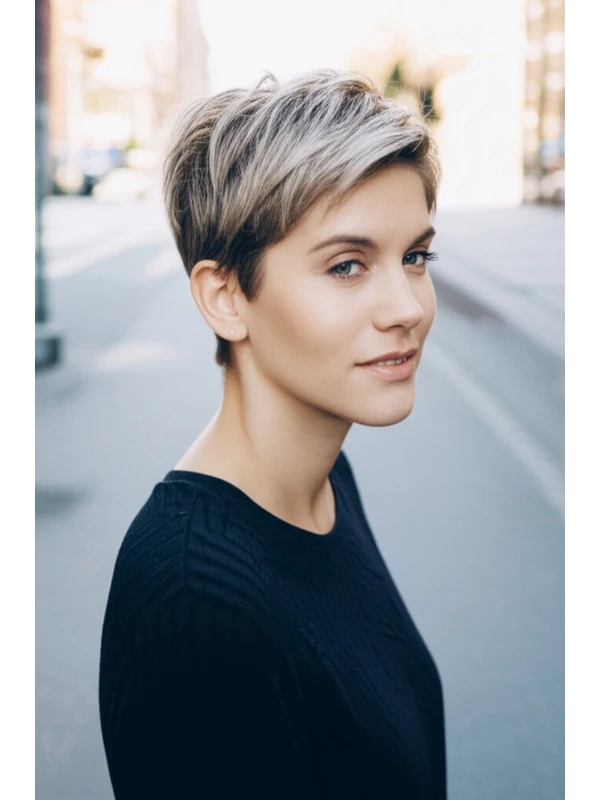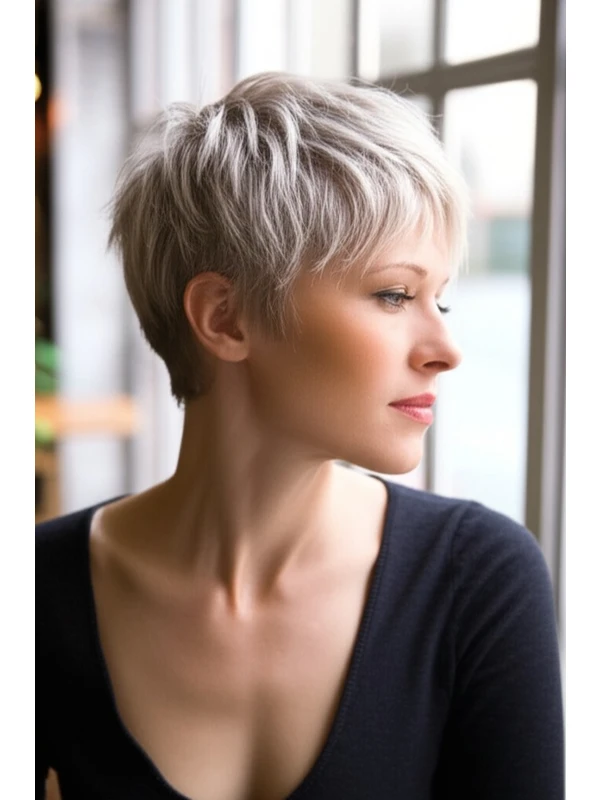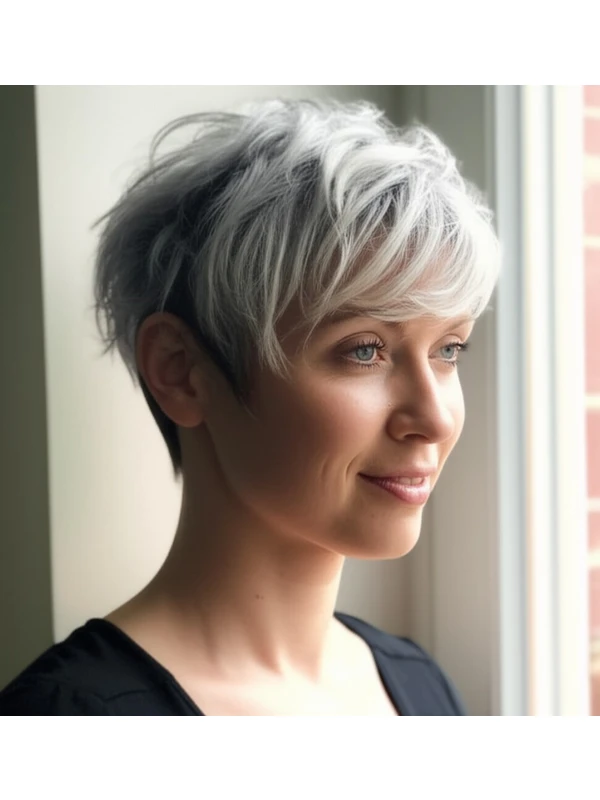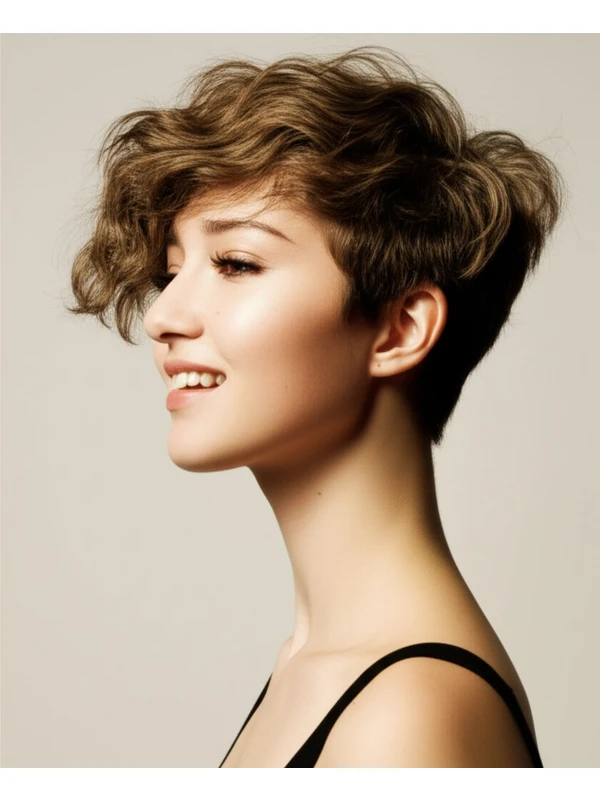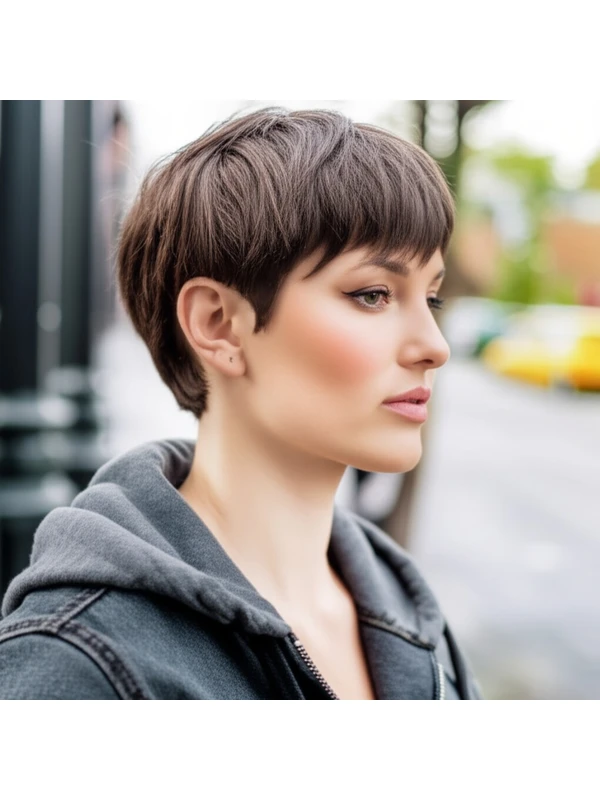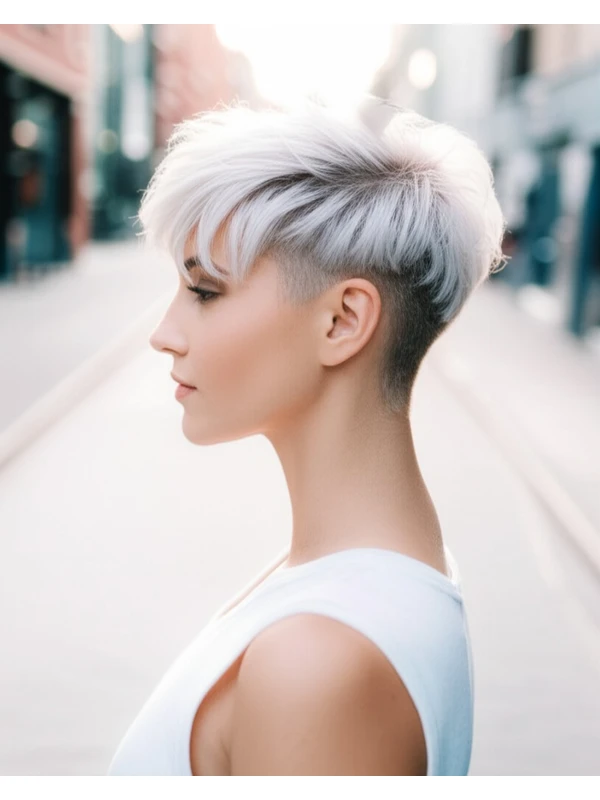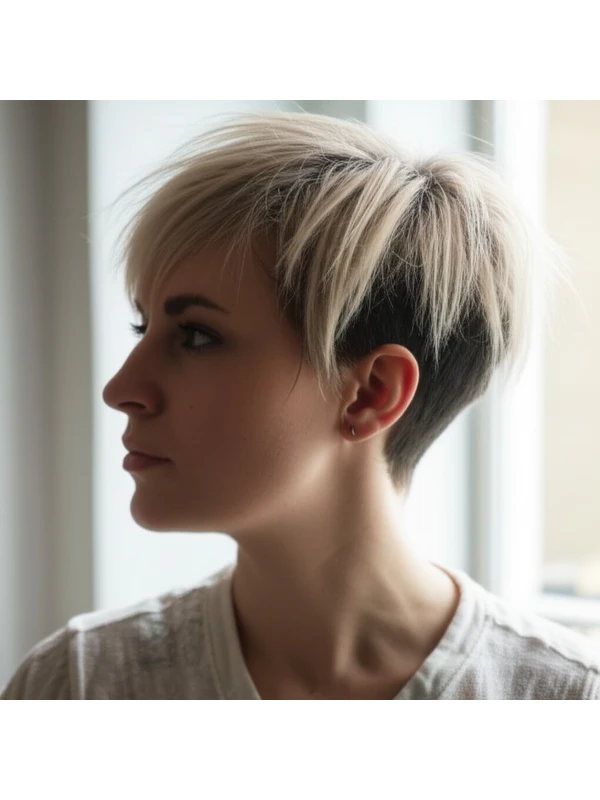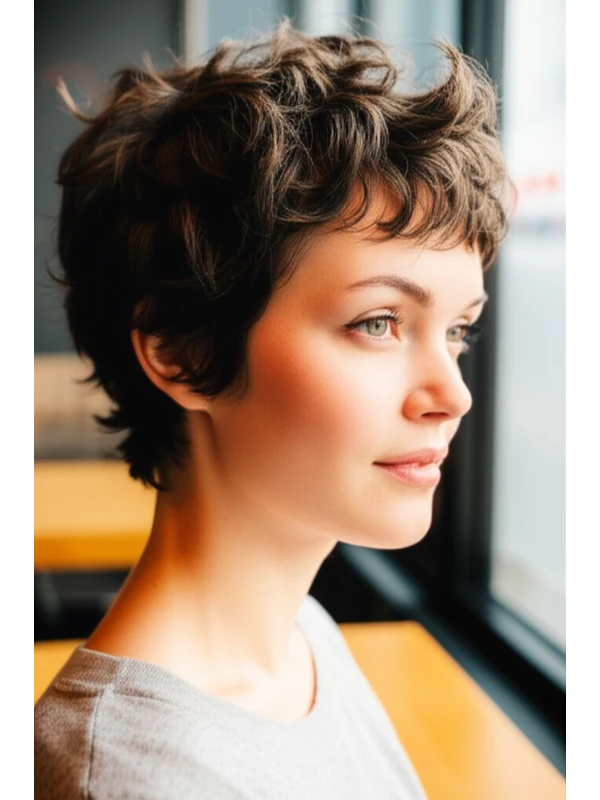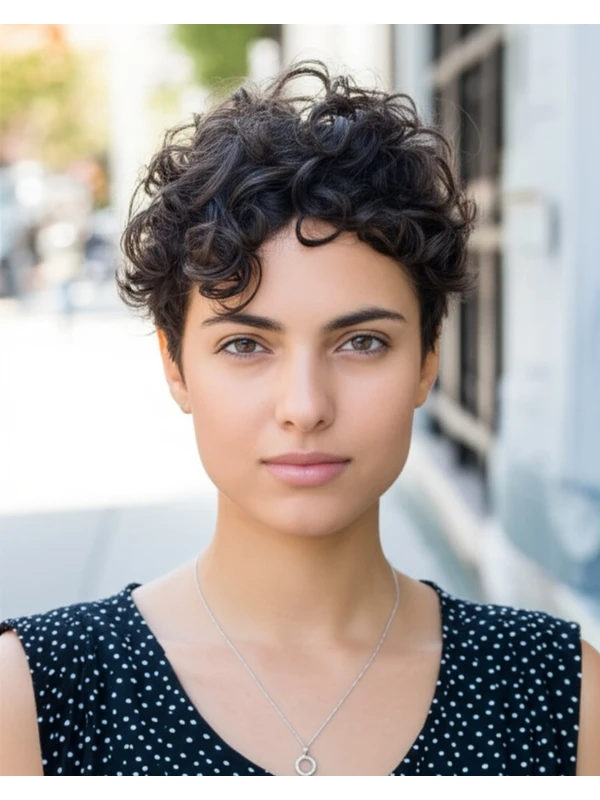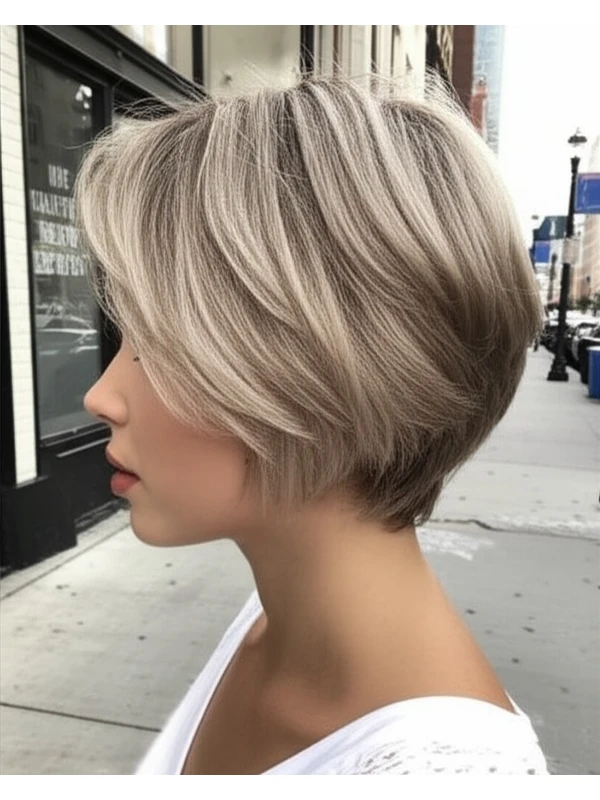#The Side-Swept Pixie: A Guide to Effortless Chic
The side-swept pixie is a timeless hairstyle known for its playful energy and low-maintenance appeal. It's a fantastic choice for those wanting something shorter, but still with plenty of style options. This guide will break down everything you need to know about this versatile cut.
#1) Background & Definition: What Is A Side-Swept Pixie?
The side-swept pixie is essentially a short haircut that's longer on top and in the front, often with a sweeping fringe (bangs) across one side of the face. It’s characterized by its close-cropped sides and back, creating a flattering contrast to the volume on top.
- Cut Geometry: The core is asymmetry – shorter at the nape and around the ears, gradually increasing in length towards the crown. This creates visual interest and allows for styling versatility.
- Key Features: A strong side part, longer layers on top for movement, a softened hairline (not bluntly cut), and often textured ends.
- Length Ranges: Typically ranges from 1-3 inches long at the longest point (top of head). Variations exist; some are very short ("boyish"), while others have more length for styling options.
- Alternative Names: Textured Pixie, Asymmetrical Pixie, Side-Parted Bob (though technically a pixie is shorter than a bob).
#2) Face Shape Fit: Finding Your Perfect Angle
The side-swept pixie can be incredibly flattering across many face shapes, but slight adjustments to the fringe and layering are key.
- Oval: Lucky you! This cut generally looks fantastic on oval faces as it highlights their symmetry. A longer, more dramatic sweep works well.
- Fringe Options: Long sweeping bangs, a soft side-swept fringe that blends into layers.
- Round: The asymmetry of the pixie helps to elongate a round face. Volume at the crown is your friend! Avoid too much fullness around the cheeks.
- Fringe Options: A longer, angled fringe that starts higher on the forehead creates lift and slims the face. Avoid blunt bangs.
- Square: Softening angles is key. The side-swept pixie works by softening a strong jawline. Layers are crucial for movement.
- Fringe Options: A soft, feathered fringe blended into layers will soften the angularity of your features.
- Heart: A wider forehead can be balanced with a slightly longer fringe that sweeps to one side. Volume at the back adds balance.
- Fringe Options: A piece-y, textured sweep is ideal; avoid anything too heavy or blunt.
- Diamond: This face shape benefits from styles that broaden the cheekbones and soften the chin. The pixie’s volume on top achieves this beautifully.
- Fringe Options: A longer fringe can help balance a wider forehead.
- Oblong (Long): Width is what you need to create! Volume at the sides is essential, as well as shorter layers throughout.
- Fringe Options: A side-swept fringe that’s relatively long and textured will add width to the face.
#3) Body Proportions & Height Guidance: Tailoring the Silhouette
The pixie's impact extends beyond just your face; it affects your overall silhouette.
- Petite: A shorter, more cropped pixie can prevent you from looking overwhelmed by hair.
- Average Height: Most variations of this cut work well for average heights.
- Tall: You can handle a longer, more voluminous side-swept pixie that adds softness to your frame.
- Narrow Shoulders: Volume on top and at the sides will visually broaden shoulders.
- Broad Shoulders: Avoid excessive volume directly over the shoulder line; instead focus on height through the crown.
- Short Neck: A shorter, more lifted style can help elongate the neck. Avoid too much length in the fringe that could make your neck appear shorter.
- Long Neck: You can pull off a longer pixie with plenty of side-swept bangs to create balance.
#4) Works Best With Hair Types & Densities: Understanding Your Texture
The success of this cut depends on understanding how it interacts with your hair.
- Straight Hair: Looks sleek and polished, but can lack volume without careful layering.
- Wavy Hair: The layers create beautiful movement and texture. Air-drying is often a great option!
- Curly/Coily Hair: Can be adapted, but requires skillful cutting to avoid bulkiness or an unflattering shape when dry. Shrinkage needs to be factored in – what looks short wet will appear longer dry.
- Density Considerations: For tighter curls and coils, a slightly longer length might be preferable for manageability.
- Fine Hair: Layers add the illusion of volume, but avoid too many layers as this can make hair look even thinner.
- Medium/Thick Hair: Layers are key to removing weight and creating shape.
- Density Tips: Thicker densities often benefit from more strategic layering to remove bulk.
#5) Styling Variations: From Casual Cool to Evening Glam
The side-swept pixie is a chameleon!
- Sleek vs. Textured: Sleek styles use smoothing products and minimal heat; textured styles embrace natural texture with sea salt sprays or texturizing creams.
- Middle vs Side Part: While the core of this style is a side part, experimenting with slightly shifting it can change the overall look.
- Fringe Variations: Longer, wispy fringe; shorter, more piece-y fringe; angled fringe; feathered fringe – all offer different vibes.
- Occasion Styling:
- Casual: Air dry with a texturizing product.
- Office: Sleek and polished with minimal flyaways.
- Evening: Add volume at the crown, use hairspray for hold.
#6) Maintenance: Keeping Your Pixie Perfect
Regular trims are essential!
- Trim Cadence: Every 4-6 weeks to maintain shape.
- At-Home Routine: Gentle shampoo and conditioner; a leave-in conditioner (especially important for curly/coily hair).
- Heat vs Air Dry: Air drying is often preferable, but heat styling can create sleekness or volume. Use heat protectant!
- Product Checklist:
- Shampoo & Conditioner: Tailored to your hair type.
- Leave-in Conditioner: For moisture and detangling.
- Styler: Mousse for volume, texturizing cream for definition, smoothing serum for sleekness.
- Finishing Spray/Hairspray: For hold.
- Estimated Daily Styling Time: 5-15 minutes (can be shorter with air drying).
#7) Grow-Out Roadmap: Navigating the Evolution
The pixie evolves as it grows!
- Months 1-3: The shape is most defined and requires regular trims to maintain.
- Months 3-6: Length starts to grow out; consider adding a few more layers for continued movement. Communicate with your stylist about your desired length increase.
- Maintaining Shape: Between cuts, focus on maintaining the side part and keeping ends tidy with quick spritzes of hairspray or texturizing spray.
#8) Color Pairings: Enhancing Your Pixie’s Dimension
Color can dramatically elevate this cut!
- Cool Undertones (pink, blue): Icy blondes, cool browns, ash tones.
- Warm Undertones (yellow, gold): Honey blondes, caramel highlights, copper reds.
- Low-Commitment Options: Balayage/highlights to add dimension without a full color change; root smudging for a softer grow-out.
#9) Season & Occasion Guide: Adapting Your Style
- Spring/Summer: Lighter colors and textured styles are perfect for warm weather.
- Fall/Winter: Richer tones and sleek, polished looks complement cooler months.
- Work: A neat, professional style with minimal fuss.
- Weddings: Elegant updo variations or soft, romantic waves.
- Parties: Playful textures and a touch of sparkle!
#10) Cost & Time: What to Expect at the Salon
- Salon Time: Typically 45-90 minutes for the initial cut.
- Price Range: Expect to pay more than you would for a trim, but less than a complex color treatment - generally in the mid-range price bracket.
#11) Pros & Cons: Weighing Your Options
Pros: Low maintenance (with regular trims), versatile styling options, flattering on many face shapes, can add volume and dimension. Cons: Requires commitment to regular trims, may not be suitable for very fine or thin hair without careful layering, can look dated if not styled correctly.
#12) Salon Consultation Script: Talking to Your Stylist
Use these prompts when discussing your side-swept pixie with your stylist:
- "I'm interested in a side-swept pixie cut. Can you show me some examples?"
- "What length would be most flattering for my face shape and hair texture?"
- “How much volume do you think I need on top?”
- “Can we discuss the best fringe option to balance my features?”
- "I prefer a low-maintenance style. What products and techniques would you recommend?"
- “What will this look like when my hair is dry, considering its natural texture/shrinkage?”
This guide provides a comprehensive overview of the side-swept pixie. Remember that your stylist's expertise is invaluable – communicate openly to achieve a cut you’ll love!
